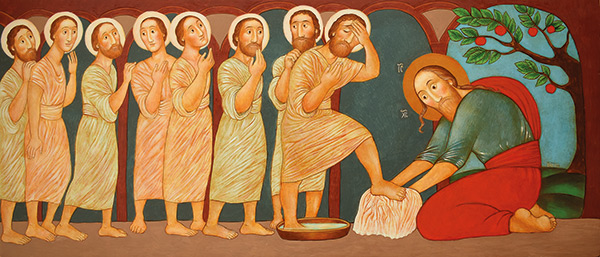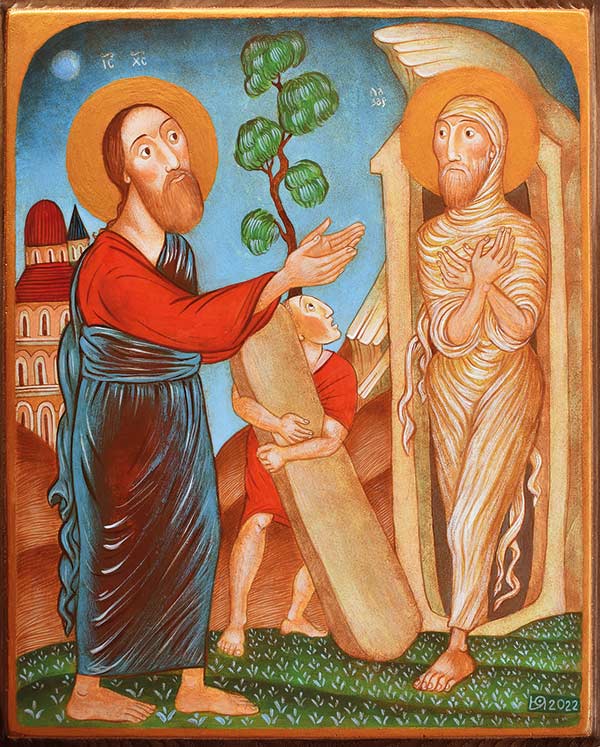Subtotal: $
Checkout-

The Last of the Cuban Revolutionaries
-

The Religion of Mammon
-

Pay As You Can
-

Ownership and Communion
-

Saving the Commons
-

History Arrives on the Island
-

On Owning Twenty-Two Cars
-

Where Your Treasure Is
-

Poem: “Clair de lune”
-

Poem: “Argument of Periapsis”
-

Poem: “Advent”
-

Editors’ Picks: Thin Places
-

Editors’ Picks: Dinosaurs
-

Editors’ Picks: Natality
-

The Mustard Seed Project
-

Feasting at Teatime
-

Letters from Readers
-

Covering the Cover: Money
-

Hudson Taylor
-

The Effective Samaritan: A Parable
-

The Justice Mothers Are Due
-

The Library at Home
-

Who Deserves Medical Care?
-

A Saver’s Grace
-

Light Came in as a Flood
-

The Other Side of the Needle’s Eye
-

Selling Friends
-

Princess of the Vatican
-

Enchanted Capitalism
-

Leper Colony Sketches

In Praise of Costly Magnificence
Mary of Bethany shows the beauty of extravagance.
By Alastair Roberts
May 26, 2023
Available languages: Español
The story is well known, though not as well as, according to Jesus, it should be.
It’s around the time of what would later be called Holy Week. Jesus is in Bethany, a town two miles or so from Jerusalem, where he has friends. One of them, a man called Simon the Leper, hosts a dinner for him and his disciples. Others are invited as well: notably, Lazarus, who not very long before this had been dead, whom Jesus had raised from his tomb, and Martha and Mary, Lazarus’ sisters. Lazarus is reclining at the table. Martha, as is typical with her, is serving; Mary, as is typical with her, is doing something else.
She comes into the dining room, carrying something. She opens it: it’s a jar, filled with “about a pound of expensive ointment made from pure nard.” She pours it on Jesus’ head, and on his feet to anoint them, wiping his feet with her hair. Judas, among others, rebukes her for this extravagance, and Jesus rebukes him for his rebuke: “Leave her alone. Why do you trouble her? She has done a beautiful thing to me. For you always have the poor with you, and whenever you want, you can do good for them. But you will not always have me. She has done what she could; she has anointed my body beforehand for burial. And truly, I say to you, wherever the gospel is proclaimed in the whole world, what she has done will be told in memory of her.”
It’s a brief, strange, powerful story that points to a reality at the center of the world, as it is transformed and set right again by Christ: the importance and inner meaning of the virtue of magnificence, and the relationship between money and love.
The accounts of the anointing of Jesus at the meal in Bethany (Matt. 26:6–13; Mark 14:3–9; John 12:1–8) are pivotal to the drama and laden with the thematic import of their respective gospels. My paraphrase above is a sort of harmonization, but there are differences between the accounts. Indeed, reading commentaries on the Gospel accounts of the anointing, one typically finds extensive discussion of their similarities, contrasts, and relationship, as well as consideration of whether Luke’s account of the sinful woman (Luke 7:36–50) is a contrasting record of the same historical occurrence. Illuminating and useful though such discussions can be, preoccupation with questions of harmonization and historicity can dull hearers’ attention to ways the Gospel writers have crafted their accounts to foreground distinctive themes and connections. Alertness to these themes and connections can relieve some of the perceived inconsistencies and tensions between them.

Julia Stankova, The Anointing of Christ, painting on canvas, 2009. Used by permission.
The Olivet Discourse directly precedes both Matthew’s and Mark’s accounts of the anointing at Bethany, while the accounts of Judas’ betrayal of Jesus to the chief priests and the Last Supper immediately follow. At first glance, their temporal setting of the event differs from that of John – his takes place six days before the Passover, rather than two (John 12:1; Matt. 26:2; Mark 14:1). By virtue of its narrative setting, however, Mary’s anointing Jesus plays a pivotal role in Matthew and Mark, seemingly provoking Judas to his betrayal. If one takes Matthew and John together, Judas is reacting specifically to Jesus’ praise of Mary and the rebuke of his own suggestion that the nard might be more sensibly and usefully disposed of – “Why was this ointment not sold for three hundred denarii and given to the poor?” – when he goes to the chief priests and asks them to make him an offer: “What will you give me if I deliver him over to you?” Indeed, we might speculate that Matthew and Mark, in speaking of “when Jesus was at Bethany” (Matt. 26:6; Mark 14:3) were referring to an earlier event, a flashback in the narrative that provides critical background for Judas’ betrayal two days before the Passover.
The actions of the woman with the nard, unnamed in Matthew’s and Mark’s accounts, are treated as prophetic or anticipatory of Jesus’ burial. He lauds her in the highest possible terms: “Truly, I say to you, wherever this gospel is proclaimed in the whole world, what she has done will also be told in memory of her” (Matt. 26:13). Her astonishing action, so scandalous to Judas, both provokes his betrayal and is contrasted with it. The perfume was incredibly costly, three hundred denarii by Mark’s and John’s accounts (Mark 14:5; John 12:5) – nearly a year’s wages for a typical laborer.
Mary’s extravagant action (matched in the immense and costly quantity of burial spices used by Joseph of Arimathea and Nicodemus in John 19:39), condemned as a waste of money by Judas and others of the disciples, is praised as a “beautiful thing” by Jesus. The Gospel writers further accent the righteous character of her actions by contrasting them with the character and actions of Judas. John records the protest as coming from the mouth of Judas, while revealing that Judas was a thief, who did not truly regard the poor as he feigned. Matthew and Mark, by connecting and juxtaposing the two events, invite their hearers to consider the jarring contrast between the costly and loving anointing of Jesus and Judas’ callous and mercenary sale of him: Thirty pieces of silver is the cost of a slave. (cf. Exod. 21:32; Zech. 11:12–13).
John’s account of the anointing is situated before Jesus’ triumphal entry into Jerusalem and is associated with events different from those in Matthew and Mark. John’s is the one that names her: neither Mary nor Martha is named more generally in Matthew or Mark. John’s account of the anointing immediately follows his account of the raising of Lazarus; he seems concerned that we connect them. Within his account of the raising of Lazarus in chapter 11, John disrupts the narrative, introducing Mary by referring to her later actions in chapter 12 (“It was Mary who anointed the Lord with ointment and wiped his feet with her hair, whose brother Lazarus was ill” – John 11:2). And chapter 12 recalls the events of the preceding chapter: “Six days before the Passover, Jesus therefore came to Bethany, where Lazarus was, whom Jesus had raised from the dead.”
What Mary sees, that Judas and the disciples miss, is that our attitude to money must be guided by love’s recognition of the all-surpassing worth of the kingdom of God, and the One in whom it is present in person.
The death of Lazarus and his raising are presented in the Gospel with tenderness and pain: “Jesus loved Martha and her sister and Lazarus,” John tells us directly; to his disciples, Jesus refers to Lazarus as “our friend.” Mary weeps before leading him to the site of her brother’s burial; Jesus himself weeps at the violation, this horror of death; he is, we are told twice, “greatly moved.” But details emerge as we read the whole story: Mary had wept at Jesus’ feet; Martha had been worried that, in opening Lazarus’s tomb, they would encounter the odor of death. And then there was the raising, this superabundant act, which brings into the present the promise of the future resurrection: Jesus loves this family, and he will not allow death the victory here. Not this time, not to these loved ones. In placing the raising of Lazarus and Mary’s anointing of Jesus alongside each other, narrating each with an explicit reference to the other, and accentuating both common and contrasting details in his accounts, John encourages his hearers to attend both to the ways that Mary’s anointing of Jesus follows from the raising of Lazarus and the ways it is illuminated by it.
In John’s account the motives for the anointing are clearly implied: the immense love and gratitude of a woman whose brother Jesus had raised from death (perhaps the identification of Mary in 11:2 suggests that, although her anointing of Jesus was well known, some of John’s hearers may not have known what occasioned it). The love that motivated Mary’s action is perhaps further heightened by John’s evocation of Song of Songs 1:12 – “While the king was on his couch, my nard gave forth its fragrance.”
Read against the backdrop of the story of the raising of Lazarus, other facets of the anointing come to the fore. The nard-scented air that fills the house contrasts with the stench of the tomb. But we might also see Jesus’ statements concerning his coming burial in a new light. Jesus’ claim that Mary is preparing his body for burial is jarring when we consider that her action is one of overwhelming gratitude to Jesus for raising her brother from death. Why refer to the grave just where we might have thought we were celebrating its defeat? Perhaps because the deliverance of Lazarus from his tomb is integrally related to Jesus’ descent into his.
Our sense that John wants us to meditate upon such questions should be heightened by the events of the following chapter, which recall the anointing at Bethany:
Now before the Feast of the Passover, when Jesus knew that his hour had come to depart out of this world to the Father, having loved his own who were in the world, he loved them to the end. During supper, when the devil had already put it into the heart of Judas Iscariot, Simon’s son, to betray him, Jesus, knowing that the Father had given all things into his hands, and that he had come from God and was going back to God, rose from supper. He laid aside his outer garments, and taking a towel, tied it around his waist. Then he poured water into a basin and began to wash the disciples’ feet and to wipe them with the towel that was wrapped around him. (John 13:1–5)
Whereas the synoptic Gospels present the institution of the Eucharist as the symbolic act related to Jesus’ coming death in the context of the Last Supper, John does not record it. Uniquely among the Gospels, John tells of Jesus washing his disciples’ feet, which fulfills some measure of the same purpose; it is, as you might say, the same “beat” in the story. By focusing his account on Mary’s anointing the feet of Jesus, in contrast to Matthew and Mark, which focus upon his head, John’s narrative accents similarities between Mary’s anointing of Jesus’ feet and Jesus’ washing of his disciples’ feet.
Jesus’ washing of his disciples’ feet is presented as an act of loving service, a remarkable action which the disciples will not truly understand until a later time (John 13:1, 7). The anointing at Bethany anticipated his burial, but his washing of the disciples’ feet seems to be a symbol of his loving service in laying down his life for them. If Mary scandalized the disciples with her extravagance, Jesus scandalized them by humbling himself on account of his love for them. In both cases, the disciples reveal their inability to perceive the lavish love at the heart of the gospel: the love of Christ for them and the answering love of those who have experienced the wonder of that love.

Julia Stankova, Christ Washes his Disciples’ Feet, painting on wood, 2022.
The prodigality of Mary of Bethany’s loving act is memorialized as an integral element of the narrative of the gospel itself and by Jesus’ own declared desire (Matt. 26:13). While we might perhaps consider her act excessive, Jesus praises it as profoundly fitting, even paradigmatic. Indeed, juxtaposed as sharply as it is with Judas’ mercenary betrayal of his Lord, perhaps Mary’s anointing is singled out for an immortality that is the inverse of his infamy.
Attitudes to money lie near the heart of the contrast between Mary and Judas’ actions. What do we believe about money? Reading other parts of the New Testament, it might be easy to assume that money is chiefly to be considered as a dangerous power from whose idolatrous control we need to free our imaginations and desires. Jesus speaks of “unrighteous mammon” (Luke 16:11) and instructs the rich young ruler to sell all he has and distribute to the poor (Luke 18:22). The New Testament frequently warns us against the love of money, “a root of all kinds of evils” (1 Tim. 6:10; cf. Heb. 13:5). Money, it might seem, is a crushing weight upon our souls, from which we need to release ourselves.
The poor are singled out as the primary recipients of God’s grace in the New Testament (e.g. Luke 6:20; 7:22), while the rich are typically characterized by spiritual blindness and insensibility (Luke 12:16–21; 16:13–14, 19–31) and are the recipients of woes. “But woe to you who are rich, for you have received your consolation. Woe to you who are full now, for you shall be hungry. Woe to you who laugh now, for you shall mourn and weep.” (Luke 6:24–25). “It is easier for a camel to go through the eye of a needle than for a rich person to enter the kingdom of God” (Matt. 19:24). “Has not God chosen those who are poor in the world to be rich in faith and heirs of the kingdom, which he has promised to those who love him?” (James 2:5).
The accumulation of great wealth is commonly associated with oppression of the poor. James describes the rich as the oppressors of the church (James 2:6–7) and of their workers, who will be avenged by the Lord (5:1–5). In his judgment upon the temple, Jesus foregrounds the figure of a poor widow, who gives all the money she has to the temple funds (Luke 21:1–4), immediately after he has condemned the wealthy scribes for devouring widows’ houses (Luke 20:46–47). When the rich tax collector Zacchaeus repents, the first thing he does is to give half of his goods to the poor and restore fourfold to any he had defrauded. Indeed, Jesus charges his disciples to sell their possessions and give to the poor (Luke 12:33).
Against all this background, Jesus’ celebration of Mary’s act might puzzle us. Putting to one side his motives as a thief, surely Judas’ protest was justified: Mary’s anointing of Jesus with the costly perfume was a wasteful act, imprudent, extravagant, even luxurious. The money should have been given to the poor instead. This, however, is to miss the animating heart of Jesus’ teaching, which was never chiefly the negative character of wealth, the injustice of economic inequality, our need to divest ourselves of our wealth, and to redistribute to the poor. Such beliefs can all too easily be driven by a spirit of envy and ressentiment, no less under the thrall of money and its kingdom of values. Judas had never escaped this, as his judgment of Mary’s action reveals.
What Mary sees, that Judas and the disciples miss, is that our attitude to money must be guided by – simply is shaped by, if we are perceiving the world aright – love’s recognition of the all-surpassing worth of the kingdom of God, and the One in whom it is present in person. The danger of money lies in the ways love of it can seduce our hearts from the One who exceeds all else in value. Recognizing this, much of the New Testament teaching concerning money should fall into place. Jesus’ charge to the rich young ruler and to his disciples to sell and give to the poor was in order that they might have treasure in heaven and freely follow him, with hearts loosed into joyful generosity by the sense of abundance that they have found in him. Jesus speaks of something similar in a pair of parables in Matthew 13:44–46:
The kingdom of heaven is like treasure hidden in a field, which a man found and covered up. Then in his joy he goes and sells all that he has and buys that field.
Again, the kingdom of heaven is like a merchant in search of fine pearls, who, on finding one pearl of great value, went and sold all that he had and bought it.
The apostle Paul speaks of this same surpassing value in Philippians 3:8:
Indeed, I count everything as loss because of the surpassing worth of knowing Christ Jesus my Lord. For his sake I have suffered the loss of all things and count them as rubbish, in order that I may gain Christ.
Mary’s act illuminates the radical transvaluation brought about by the love of Christ – the all-surpassing love that we have tasted and the answering love that rises in our hearts through his Spirit. And here we might begin to understand something of the significance of John’s analogy between Mary’s loving anointing of Jesus’ feet and his washing of his disciples’ feet. Jesus’ washing of his disciples’ feet manifests the reality of his coming death, his “taking the form of a servant” and humbling himself to the point of death on the cross (Phil. 2:5–8). This was an act of surpassing love: “For you know the grace of our Lord Jesus Christ, that though he was rich, yet for your sake he became poor, so that you by his poverty might become rich” (2 Cor. 8:9). What Paul says specifically in Philippians is that Jesus “emptied himself.” He poured himself out with a lavish hand, in taking his servant’s form and in dying. And by the love that alone can begin to fathom this marvelous self-gift, we will want to respond in kind.
The self-gift of our Lord is eternally memorialized, but the gift of Mary is remembered too. Unlike the man who would sell him for thirty pieces of silver, Mary recognized Jesus’ incomparable value and acted accordingly. In the magnificent extravagance of her act, not motivated by the desire for praise – indeed, in the face of censure – Mary fittingly expresses this truth that the eyes of Christian love alone can see.

Julia Stankova, The Raising of Lazarus, painting on wood, 2022.
It is, in the most precise sense, a magnificent gesture. While the Aristotelian virtue of magnificence was largely restricted to the rich and powerful in the ancient world, Mary’s act illustrates its place at the heart of Christian practice. Because we are children of a King, we can act like it, with a kind of prodigal generosity. We don’t need to spend all our lives scrimping. We have enough; we have, in fact, everything. Mary exemplifies the joyful liberality of love’s answer to unfathomable grace, a magnificence that is conformed to the immeasurable self-gift to which it responds.
For too many of us, money remains the ultimate measure of value, never having been eclipsed by Christ and his kingdom. The Victorian writer John Ruskin sought to expose some of the deep errors that arise when we treat money as the measure of all things. The only true value, Ruskin insisted, is life. Where riches are accumulated in the service of oppression, destruction, greed, and vice such “wealth” is utterly contrary to the “weal.” In a powerful passage, Ruskin compares this to the flowing of water:
Wealth, therefore, is “the possession of the valuable by the valiant.” … The two elements, the value of the thing, and the valour of its possessor, must be estimated together. Whence it appears that many of the persons commonly considered wealthy, are in reality no more wealthy than the locks of their own strong boxes are, they being inherently and eternally incapable of wealth; and operating … either as pools of dead water, and eddies in a stream … or else, as dams in a river, of which the ultimate service depends not on the dam, but the miller; or else, as mere accidental stays and impediments, acting not as wealth, but (for we ought to have a correspondent term) as “illth,” causing various devastation and trouble around them in all directions; or lastly, act not at all, but are merely animated conditions of delay (no use being possible of anything they have until they are dead).
In the Gospel of John, similar motifs of flowing arise at several points. In John 4, in talking with the Samaritan woman at the well, Jesus offers living water that will become in its recipient “a spring of water welling up to eternal life” (verse 14). In chapter 7, in speaking of the Spirit that would be given at Pentecost, Jesus declares “out of his heart will flow rivers of living water” (verse 38). In recording the events of the crucifixion, John draws our attention to the fact that water mixed with blood flowed from Jesus’ pierced side (19:34–35). Jesus’ self-gift, his pouring out of his life for mankind, compared to water, makes its recipients into springs of living water themselves.
In answer to his disciples’ rebuke of Mary, Jesus declares: “The poor you always have with you, but you do not always have me” (John 12:8). After the Ascension, it would no longer be possible to perform such a magnificent act as Mary performed upon Jesus’ physical body. Yet Jesus still has a body on earth, toward which we can still express our love, which calls out for our magnificence. In Matthew 25, the chapter before the anointing at Bethany is recorded, Jesus speaks of how loving deeds done towards “one of the least of these my brothers” are done to him (verses 31–46).
The pouring forth of life – true life – from Jesus produces a new economy, of which the magnificence of loving self-gifts such as Mary’s is characteristic; her anointing of Jesus at Bethany is described in a way that evokes both the memory and anticipation of God’s own gift of his Spirit. Elsewhere, when we read of something filling a house, it is almost invariably God’s own presence by his Spirit (Exod. 40:34–35; 1 Kings 8:10–11; 2 Chron. 5:13–14; 7:2; Isa. 6:4; Ezek. 10:3–4; Acts 2:2). As the scent of her nard fills the house at Bethany, the Spirit of love is mysteriously manifest.
The one gift of the Spirit at Pentecost, poured out by the ascended Christ in loving magnificence, produces an “economy” of life in his body, as by many gifts of that one Spirit its members liberally minister the life that they have received to others. Paradoxically, this life is received in the act of giving. Like living water, it does not stand still or stagnate or get dammed up, but exuberantly flows from each to his neighbor, in countless tributaries of loving self-gift, from its source in the inexhaustible spring of Calvary.
Already a subscriber? Sign in
Try 3 months of unlimited access. Start your FREE TRIAL today. Cancel anytime.










































Houston
As artists, my wife and I both have a tattoo of Mary's jar of perfume for this reason. Beautiful extravagance. Wonderful piece!
Rindy Trouteaud
Magnificent article! You tie together the riches of gospel stories in such fresh, eye-opening ways. I am grateful for your work which encourages me to read these familiar stories "as if for the first time". Thank you!